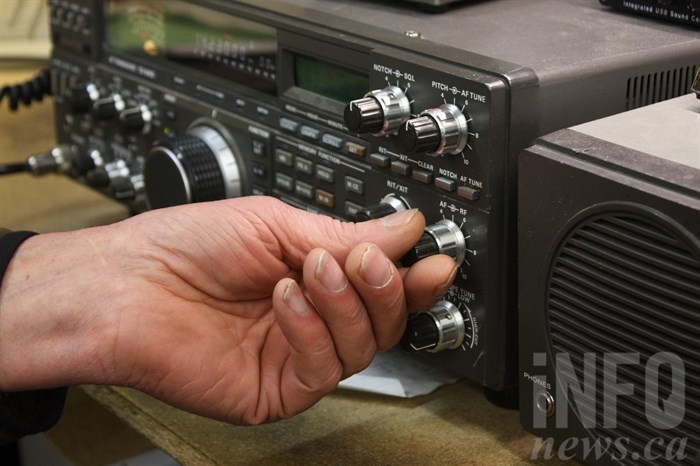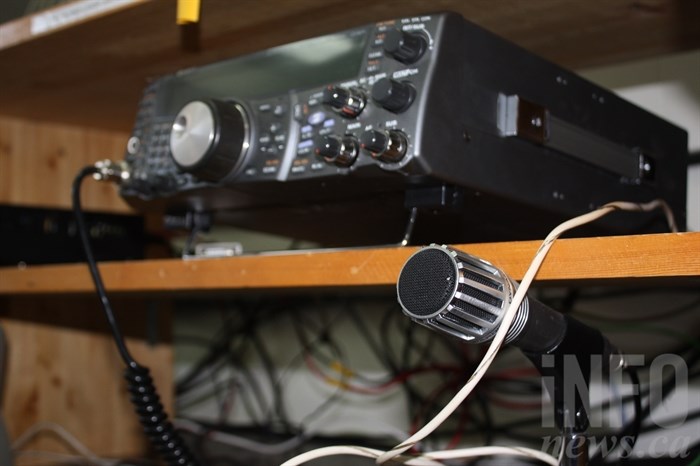
Lorne Klassen makes a call-in with his radio.
(SEAN MOTT / iNFOnews.ca)
February 27, 2019 - 6:30 PM
KELOWNA - There are currently three people living in outer space. Anne McClain, Oleg Kononenko, and Canada's David Saint-Jacques have been floating above earth at the International Space Station for three months. Lorne Klassen wants to talk to one of them.
"It's something to tick off my bucket list," he said.
Klassen isn't waiting for the astronauts to come back down to earth; in fact, he won't even have to leave his garage to have a conversation. He just needs the space station to line up with his antenna as it orbits the world 400 kilometres up.
Klassen's garage looks like a typical hobby shop. Tools and bolts are neatly sorted in labeled drawers and files. A four-wheeler rests near the car entrance. But in the far corner Klassen has built something usually not seen outside of remote research stations: A desk filled with amateur radio equipment. Different radios, speakers, and handheld devices line the table.
Outside, an antenna straddles the roof of the garage, securely tied to trees around the building. Klassen has built an amateur radio heaven in his backyard. He's part of a small but dedicated group of enthusiasts in the Okanagan who are keeping an old, vital form of communication alive.
By Klassen's estimation, the space station passes over the Kelowna area three or four times a day. He keeps an eye on its path, monitoring his radio. The station's signal is strong, but Klassen's radio needs a fairly straight line to connect with it. Not too long ago, Klassen made contact with the station and received an image through the signal. The technique is called slow scan, which gradually transfers a photo from outer space into Klassen's computer in his garage. The pictures can be grainy and distorted, but all the same, he has photos from space.
Klassen has been interested in amateur radios since he was a kid. When he was 12, he tried to get an amateur radio license, but at the time the test for it required a morse code portion. Klassen could never crack that part.
"I tried, but at 12 years old it wasn't going to happen," he said.
Klassen's amateur radio interest slid into the background until about six years ago when we stumbled across a website that stated the morse code requirement had been removed from the test. Klassen took the test and passed. He started collecting radio equipment and he quickly discovered there is an entire world of amateur radio hidden in the Okanagan.

Lorne Klassen adjusts a dial.
(SEAN MOTT / iNFOnews.ca)
Big Signals
Sitting in their radio room, Gordon Hawkey and Brian Porter both laugh when someone calls their handheld communicators "walkie talkies" or "handy talkies."
"Americans have corrupted them calling them handy talkies," Porter said. "We call them handhelds."
The handhelds are two-meter amateur radios, a portable form of communication. They lack the range and power of bigger radios, but they get the job done in a pinch. Both Porter and Klassen said they're useful for outdoors adventures since many wooded areas have spotty cell service. A handheld can be a lifeline.
Porter and Hawkey are often surrounded by various radios. They're members of the Orchard City Amateur Radio Club, which keeps the spirit of Ham operators alive in Kelowna. The club offers lessons for aspiring communicators, using a station in Kelowna full of equipment for training and contests.
The station is jam-packed with receivers, speakers, and even morse code paddles. Hawkey points to a section of wall covered in wires. It looks incomprehensible to the average eye, but it's a delicate system that interconnects the building's four antennas.
"We call it the Octopus," Hawkey said.

Gordon Hawkey looks over the Octopus.
(SEAN MOTT / iNFOnews.ca)
The station serves as a focal point for amateur radio enthusiasts. Porter, who's also the president of club, said they have 58 members. According to the Government of Canada database, 437 people in Kelowna have registered amateur radio call signs. It's a community.
Members keep their skills sharp by volunteering at events that need instant communication, like marathons. People like Hawkey and Porter will be stationed around a race, feeding information to workers throughout the track. At large events, an open radio line can often keep people up-to-date better than cell phones.
The Orchard City club isn't the only game in town. Klassen is part of the North Okanagan Radio Amateur Club in Vernon.
Twice a week he sits in his garage and listens as a variety of voices filter through his radio. People throughout the Okanagan pop in with weather tips and updates. It's part of an area-wide check-in. The radio clubs call around the Okanagan to hear from members, crack jokes, and make sure everyone's equipment is working.
"If you need this stuff in an emergency, you want to make sure they’re working," Klassen said.
Emergency Connections
In 2003, as the fire raged in the Okanagan, emergencies services were worried about Cranbrook. A Telus site in the area was in danger of being consumed by the flames and if it went down, there'd be no cell service. According to Hawkey, Interior Health came to the radio club for help.
"They came to us to ask if we could create a radio link from Kelowna to Cranbrook so they would have a method of communication if the telephone system failed," he said.
Working with the Vernon club, Kelowna was able to connect repeaters (devices that re-transmit radio signals to boost their reach) to create a link to Cranbrook. Emergency services never needed the link, but it was there.
"That’s why we have many modes of communications, so if something doesn’t work you can fall back on something else," Hawkey said.
Amateur radio might be seen as an antiquated form of communication, but the Orchard City club sees it as a vital tool. During emergencies, when communication is crucial, a two-meter handheld might be the most direct way to contact someone, especially if cell service is spotty.
"If you’re looking for some capability to get out of an emergency, what better way than amateur radio?” Hawkey said.

One of the radio setups at the Orchard City club's station.
(SEAN MOTT / iNFOnews.ca)
Worldwide Reach
Klassen has been around the world with his radio. He has a scrapbook full of slow scan photos from Texas, Russia and Great Britain. He's managed to chat with another amateur radio enthusiast in Australia. He's still fascinated by the power of the radio.
"There’s no infrastructure between this radio and who I’m talking to," he said. "There’s no phone lines, nothing. The signal goes out of this radio, up to the antenna, bounces off the ionosphere and goes to [the man in Australia]. I find that whole concept fascinating.”
Amateur radio seems to connect people, whether they're across the world or in the same neighbourhood.
"It's a social thing for me," Hawkey said. "I've met quite a few people. It's been an interesting journey."
Amateur radio continues to chug along in a world full of cell phones and instant messaging, its practitioners making connections around the world. Lorne Klassen, keeping his ears open, continues honing his skills and reaching out to people through his radio, waiting for a possible connection to the space station.
To contact a reporter for this story, email Sean Mott or call (250) 864-7494 or email the editor. You can also submit photos, videos or news tips to the newsroom and be entered to win a monthly prize draw.
We welcome your comments and opinions on our stories but play nice. We won't censor or delete comments unless they contain off-topic statements or links, unnecessary vulgarity, false facts, spam or obviously fake profiles. If you have any concerns about what you see in comments, email the editor in the link above.
News from © iNFOnews, 2019